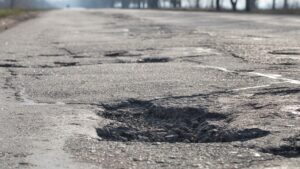By Cat Stardew. Last Updated 5th July 2023. This is a guide discussing pothole claims. You may be eligible to make a claim if you have been injured in an accident involving a pothole due to a third party breaching the duty of care they owed you. This guide will take you through the eligibility criteria for personal injury claims as well as the evidence you can gather to strengthen your case.
Additionally, we will discuss the duty of care those in control of a public space owe you and the responsibilities they have to address potholes on certain roads.
Also, we provide examples of the type of injuries you could sustain from a pothole accident, and the possible compensation you could claim for those injuries.
This guide also includes a breakdown of the advantages involved in working with a solicitor under a specific type of No Win No Fee agreement.
For more information, you can contact our team with any queries you may have about pothole claims whilst, or after, reading our guide. To reach them:
- Call on 0161 696 9685
- Contact us online
- Use our live chat feature
Select A Section
- A Guide To Pothole Claims
- Who Is To Blame In Pothole Claims?
- Injuries Caused By Pothole Accidents
- Essential Evidence In Pothole Claims
- Estimated Compensation Payouts For Pothole Accidents
- No Win No Fee Pothole Claims
- Further Guidance On Claiming For Pothole Accidents
A Guide To Pothole Claims
A pothole is a depression formed when a paved surface is worn away. They can present a hazard to several people, including pedestrians, cyclists, motorcyclists, and drivers of vehicles.
The Highways Act 1980 and the Occupiers’ Liability Act 1957 places a duty of care on those responsible for the highways network to ensure they are reasonably safe for members of the public to use.
In order to make a public liability claim, you need to satisfy the following requirements:
- A duty of care was owed to you.
- This duty of care to you was breached.
- This breach was the cause of your injuries.
Time Limits
Personal injury claims are subject to the time limit set out in the Limitation Act 1980. This states that you will generally have 3 years from the accident date to start your claim. However, in certain cases, exceptions to this limit can apply.
If you would like to know more about the time limits for public liability claims and any exceptions that may apply to your particular case, you can reach our advisors using the contact information above. They can also answer any other questions you might have regarding pothole claims.
Who Is To Blame In Pothole Claims?
On roads that are not private or unadopted, the local council is generally responsible for the upkeep and maintenance of the road and the pavement. If a member of the public spots a pothole or other defect, they can then report it to the council or highway authority, who will then assess and potentially repair it. National Highways are the body responsible for maintaining motorways and major roads in England.
If the council has been made aware of a pothole and they fail to repair it within a reasonable timeframe, resulting in accidents or injuries, then they may be liable in a pothole injury claim. This is because, as we mentioned above, your injuries must be caused by a breached duty of care in order to form the basis of a valid claim.
However, if they were not aware of the fault, or if they are still within a reasonable timeframe to carry out repairs, then you may not be able to claim.
To learn more about pothole claims and the responsibilities of your local council or highway authority, contact our team of advisors today.
Injuries Caused By Pothole Accidents
There are different types of accidents that could occur due to a pothole. For example, pedestrians could slip, trip or fall on a pothole when crossing the road. Additionally, drivers could lose control of their vehicle when going over a large pothole, or in an attempt to swerve and avoid a pothole in the road. They could also slam on their brakes after noticing a pothole, causing a rear-end collision.
The different types of injuries that could be sustained as a result of these pothole accidents can include:
- Soft tissue injuries, such as an Achilles tendon injury
- Broken or fractured bones
- Head injuries, such as concussion or brain damage
- Back injuries, such as slipped discs
- Cuts, bruises and lacerations
After a breach of duty has caused an injury in an accident involving a pothole, claims that are successful can mean a settlement is awarded to compensate for the different ways an injury has affected a person’s life.
To learn more about how personal injury compensation is calculated, continue reading. Alternatively, get in touch with an advisor to find out what steps you could take if you have been injured in a pothole accident.
Essential Evidence in Pothole Claims
Providing a strong body of evidence in support of your personal injury claim is important. Evidence not only helps prove liability but provides information on the extent of your injuries. Some examples of evidence that could support pothole claims are:
- Photographs: For example, you could take a photograph of the pothole that caused the accident. You could also take pictures of your injuries, and any damage that was caused to your vehicle.
- Video footage: A copy of any CCTV footage or dashcam footage of the accident could be acquired.
- Medical evidence: This can include copies of your medical records, including doctor reports, X-ray scans and test results.
- Witness contact details: Any potential witness could provide an account of how the accident happened later down the line.
If you would like support in gathering evidence, you can get in touch with our advisers. They can offer advice and potentially connect you with a solicitor from our panel who could assist you in different ways, including building your case as well as presenting it within the time limit for pothole claims.
Estimated Compensation Payouts For Pothole Accidents
If your public liability claim succeeds, you will be awarded a personal injury settlement amount comprising compensation for the physical and emotional pain and suffering you have experienced due to your injury; this is awarded under general damages.
Solicitors can use the Judicial College Guidelines (JCG), a publication that contains guideline award brackets for injuries, alongside any medical documents to calculate the possible value of the harm you sustained. A selection of JCG brackets has been used to create the table below.
As every personal injury claim is assessed individually, this information has been included as a guide only.
Compensation Table
| Injury | Severity | Description | Amount - Guideline |
|---|---|---|---|
| Facial Injuries | (b) Multiple fractures of facial bones | Injuries involving some permanent facial deformity. | £14,900 to £23,950 |
| Facial Injuries | (c) Fractures of nose or nasal complex (i) | Serious or multiple fractures resulting in permanent airway damage, breathing difficulties and damage to nerves or tear ducts. A number of operations are also required. | £10,640 to £23,130 |
| Wrist Injuries | (b) Significant permanent disability | Injury resulting in significant permanent disability, but where some useful movement remains. | £24,500 to £39,170 |
| Wrist Injuries | (c) Less severe | Injuries where there is still some permanent disability, such as a degree of persisting pain and stiffness. | £12,590 to £24,500 |
| Knee Injuries | (a) Severe (i) | Serious knee injury where there has been gross ligamentous damage, development of osteoarthritis, considerable pain and loss of function. | £69,730 to £96,210 |
| Knee Injuries | (a) Severe (ii) | Leg fracture extending into the knee causing constant, permanent pain, limitation of movement and impairment of agility. | £52,120 to £69,730 |
| Ankle Injuries | (a) Very Severe | Cases involving a transmalleolar fracture with extensive soft-tissue damage resulting in deformity. | £50,060 to £69,700 |
| Ankle Injuries | (c) Moderate | Fractures or ligamentous tears which give rise to serious disabilities such as difficulty walking for long periods, awkwardness on stairs and irritation from metal plates. | £13,740 to £26,590 |
| Foot Injuries | (e) Serious | Injuries leading to continuing pain from traumatic arthritis or risk of future arthritis, prolonged treatment and fusion surgery. | £24,990 to £39,200 |
| Foot Injuries | (f) Moderate | Displaced metatarsal fractures resulting in permanent deformity and continuing symptoms. | £13,740 to £24,990 |
Special Damages.
If you have experienced monetary losses due to your injuries, you could claim compensation for these under special damages, the other head of claim that could make up your settlement. Some examples of costs that could be reimbursed as part of pothole claims are listed below:
- Travel costs
- Loss of earnings
- The cost of home alterations
- Domestic care costs
Remember to keep any documentation that demonstrates your financial losses, such as receipts, invoices or bank statements.
If you would like a free, personalised estimate of how much your potential settlement could be worth, please get in touch on the number above.
No Win No Fee Pothole Claims
After assessing the validity of your claim, our team of advisers could connect you with a solicitor from our panel. If eligible, you could then be offered a Conditional Fee Agreement (CFA), which is a type of No Win No Fee contract.
Making a claim with a solicitor who offers their services under these terms could benefit you in several ways. First of all, you generally do not have to pay any upfront fees for the solicitor’s services or any fees for their work as your claim progresses. If the claim fails, there are no fees to pay for the work they have done on your case.
If you win your claim, the solicitor will take a percentage of your compensation amount as a success fee. This percentage is legally capped, so you will keep most of your settlement.
For more information about pothole claims, you can contact our team today by:
- Calling on 0161 696 9685
- Using our ‘contact us‘ form
- Using our live chat feature
Further Guidance On Claiming For Pothole Accidents
For more of our guides:
- Read our guide for information on making public liability insurance claim.
- Learn about the process of seeking compensation for an elbow injury.
- Read about how much you could claim for a sprained ankle.
For more resources:
- GOV.UK: Road accidents and safety statistics
- GOV.UK: Report a pothole
- NHS: First Aid
Thank you for reading our guide on pothole claims. For more guidance, you can get in touch with our team of advisers using the contact details above.
Written by HC
Edited by MMI


